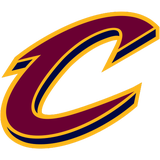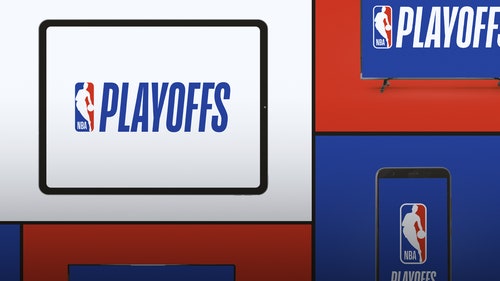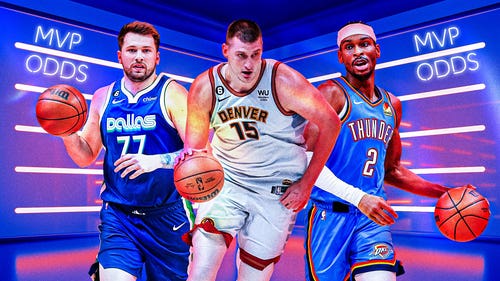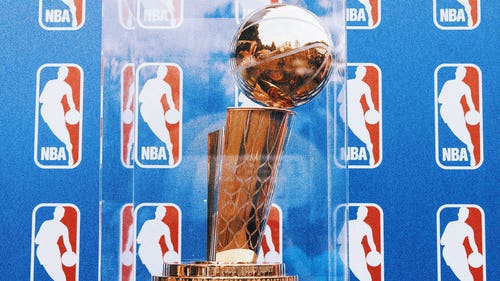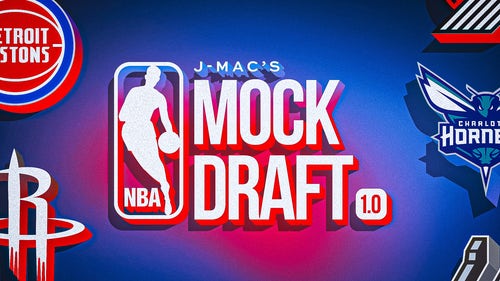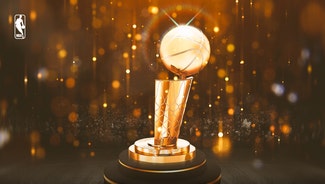
The NBA Hasn't Come Easy To Brandon Ingram, But It Will
It began with Brandon Ingram snatching a rebound out from over Kyrie Irving. Ingram turned and charged up court, swinging one lanky leg in front of the other. His arms, so long that he easily palm dribbled below his knees, moved like a slinky rolling down a set of stairs.
A pace beyond halfcourt, Ingram surveyed the Cavaliers’ retreating defense. He noticed J.R. Smith sagging too far into the paint and whipped a pass to Jordan Clarkson waiting patiently in the opposite corner. Clarkson promptly slipped around Smith’s closeout to loft a 10-foot floater into the net.
The nine-second fast break was a microcosm of what makes Ingram such a tantalizing prospect—an impossible inside-out scoring threat compounded with playmaking ability and a worldly defensive prowess—and a snapshot of his nine-point, nine-assist and 10-rebound effort as the Lakers’ starting point guard last Saturday.
The sequence is also a glimpse into why many have been disappointed by the No. 2 overall pick two months into his NBA career. Ingram drew Cavs big Tristan Thompson in transition, a situation in which he was billed capable of dancing past and scoring with his rare speed and size. Instead, he quickly took his eyes off the rim and deferred to an open teammate.
Matching up against smaller defenders hasn't been easy either, as the Lakers rookie has struggled to find his footing and position on post-up attempts. He’s shooting—gulp—27.1% from three-point land, often adding a subconscious windup to his motion to get the ball over the rim. He strangely steps out of bounds far too frequently. And some of his baseline drives look far too similar to a baby giraffe sprawling onto the floor.

Yet, to say the Lakers are being patient with Ingram’s offensive development would be an understatement. “He’s going to be a hell of a player,” veteran teammate Luol Deng said, a sentiment echoed throughout the locker room. It’s the transition from collegiate to NBA defense that the L.A. coaching staff has zeroed in on. Ingram’s length is a nuisance for opponents, and if he gets beat, that interminable 7’3" wingspan allows him to recover with a chance to still protect the rim. But that slender frame can get absolutely crunched when he’s guarding high ball screens, and his overall grasp of team pick-and-roll defense has plagued the Lakers.
“Rotations and from the weakside,” head coach Luke Walton said of Ingram's defensive shortcomings. “His on-ball defense is fine, it’s more of seeing the actions and anticipating the actions, which is tough. ... As a kid coming out of college, you don’t know that stuff. You’re not familiar with it yet.”
Ingram pretty consistently does a good job tagging roll men—being just physical enough to deter an easy diive to the rim—but then often fails to return to his man. There are also far too many occasions where a lack of synergy with his frontcourt teammate defending ball screens yields an easy bucket. Watch as Ingram gets lost in the shuffle of the Kings’ sneaky dribble hand off that feeds right into a side pick-and-roll.
As Clarkson steps in to tag the rolling Willie Cauley-Stein, Ingram motions for Clarkson to retreat to Ty Lawson in the corner. But the defensive principles baked into the Lakers’ preferred hedging pick-and-roll defense suggest Ingram should have instead recovered to Arron Afflalo at the top of the key—relieving Thomas Robinson of his hedge and freeing Clarkson to retain responsibility of Lawson.
“It’s really different from college,” Ingram admitted. “The defensive three seconds; it’s basically about being in spots to help my teammates and being in the right positions.” He’s likely watched the play above dozens of times. “He’s a student of the game, he watches tape,” Walton said. Deng and Metta World Peace have helped in teaching Ingram as well. Long ago, Deng was a 19-year-old rookie himself. “There’s no magic. You have to put in the work,” Deng said. “In the beginning it’s hard to be consistent. But as time goes on, it just becomes second nature.”
Offensively, you can’t teach Ingram’s innate comfort with the ball in his hands. He’s adapted to NBA speed rather seamlessly. He can manipulate defenders as the ball swings around the perimeter, like ball-faking to corner shooters as the defense rotates to create an open look for the man who passed to him. Two-time NBA All-Star Jerry Stackhouse noticed that ability when he first coached Ingram in AAU as a 7th grader. “There was a foundation of knowing how to play and how to share the basketball,” said Stackhouse, the current head coach of the D-League Raptors 905.

Ingram’s tenure with Stackhouse’s AAU team was nearly short lived. After weeks of initial practices, he refused to play in the club’s first weekend tournament in Richmond, Va, struck by a bout of nerves. But as punishment for not taking the trash out, Donald Ingram forced his gangly son to join his teammates on the court, opening the curtain to the national stage on which he would soon blossom. “That’s why you gotta listen to your parents,” Stackhouse said.
Nearly 25 years ago—and two decades before Brandon led Kinston High to four straight state titles—it was Stackhouse who perfected the role of town prodigy, testing his game against local legends in premier pickup outings. Donald ran the Kinston gyms. Having returned to his hometown in North Carolina following a semi-professional playing career, the elder Ingram barked as loud as his bite. “Brandon can shoot the ball, he probably shoots it half as good as his dad did,” Stackhouse said. “You talk about literally step across half court and let it go. And it was all net.” The younger Ingram showed off the family trade for Duke a year ago, draining 41% of his triples as he skyrocketed up draft boards.
In Los Angeles, Ingram has struggled from deep, sometimes peculiarly. NBA.com has tracked Ingram's three-point shooting at a puzzling 26.2% when wide open compared to 33.3% with a defender less than 2 feet away. “I know my percentages will go up. It’s really just getting in a rhythm,” Ingram said. “It’s been looking good outside of the games in practice.”
Perhaps those struggles are a product of his role. Catch-and-shoot situations represent only 25.4% of Ingram's attempts, where as a player like Paul George—who Ingram is often compared to—utilizes 32.6% of his respective shots as catch-and-shoot opportunities on a far higher usage rate. Even with his 6'9" frame, Ingram has largely manned the point for Lakers bench units, deferring to Clarkson and Lou Williams. “The positions that they’ve put him into, I think he’s responded very well,” Williams said. But it begs the question, have the Lakers yet truly placed Ingram in an optimal role?

Of late, the L.A. staff has encouraged him to play with an increased aggression, hunting more shots. It's an mindset Ingram will likely have to employ to one-day become a go-to scorer alongside point guard D'Angelo Russell, who's lingering left knee injury has provided Ingram opportunities to start. Or perhaps, Walton's Ingram-at-point-guard experiments are preparing him for a future share of the Lakers' lead ball–handling duties with Russell, similar to how the Toronto Raptors feature both Kyle Lowery and DeMar DeRozan. Regardless, answering the call to assert himself more will require flipping the switch Stackhouse first before Ingram’s senior year of high school.
The recently retired Stackhouse had returned home to work out with his star pupil. He bullied Ingram in the post, utilizing his power and strength. On one possession, Stackhouse gripped Ingram’s arm with his offhand, preparing a bulldoze towards the rim. “I mean literally we was there probably 30 seconds when we were playing pickup ball, and he didn’t do anything,” Stackhouse recalled. “It was just to the point like, ‘Man, if you don’t get my hand off of you! You can not let anybody, me or anybody else, hold you like this.’ And that was one of those moments where the light flicked on and it’s like ‘Ok, you’re not gonna out-physical me.’”
The subsequent play, a crossover and a shoulder into Stackhouse’s chest later, Ingram finished at the rim with ease. “He was really going at me. And I was like, ‘Ok!’ This isn’t the same kid,” Stackhouse said. The following year, after dispatching Yale to advance to the Sweet 16 in the NCAA tournament, Ingram told SI.com: “I can battle anybody in the country. Anybody that goes out on the floor, I’m trying to attack them and I’m trying to make a name off of them.”

His Duke teammates sometimes doubled as spectators, watching in awe at his glides to the rim. “He’s a guard, a big man, a shot blocker, a defender, a stopper,” said Duke sophomore guard Luke Kennard. Ingram excelled in a playmaking role at Duke similar to how Walton has utilized his diverse skillset, often taking turns with Grayson Allen to initiate the offense. He torched defenses methodically.
“The poise he shows and the decision making he has on the floor, he shows maturity beyond his years,” said Knicks center, and former Duke teammate, Marshall Plumlee. “The intangibles with him, for being the high-caliber player he is, that’s what’s really impressed me the most.”
Teammates, coaches, his father, opponents: Everyone around Ingram has labeled him as “unique.” Duke coach Mike Krzyzewski was nearly left speechless after Ingram’s 25-point, five-rebound outing in that nail-biter vs. Yale. "You put 20 pounds on him," he said, struggling to find the appropriate words. "There's nobody like him." They praised his repertoire of ball skills, demeanor and work ethic, speaking of Ingram like a wondrous prodigy.
The potential is seemingly endless, and it’s easy to forget Ingram is 10 months younger than his draft counterpart Ben Simmons. Relishing his flashes of brilliance is like getting excited about an upcoming movie’s IMDB page, let alone the trailer. There’s still muscle to grow and endless jumpers to hoist. The early returns on his rookie season have been objectively frustrating and inconsistent. He’s bounced between the starting lineup and second unit. But when Brandon Ingram finds a rhythm, you’ll know.
